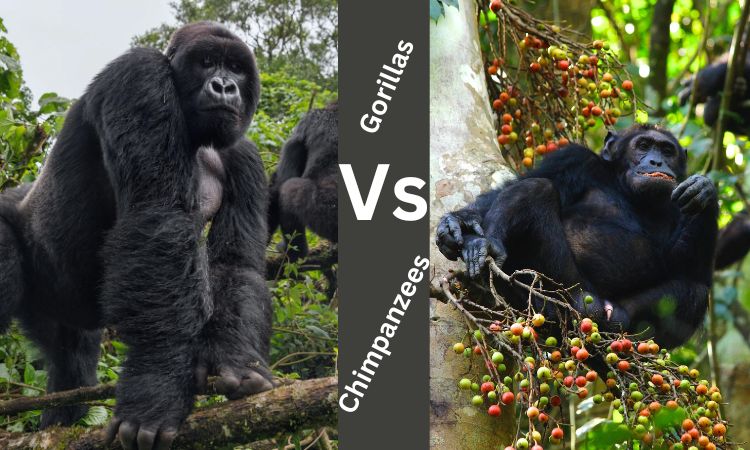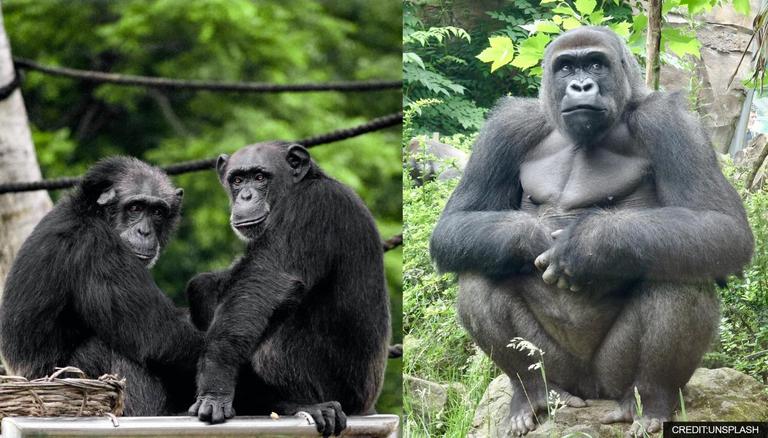Chimpanzee Vs. Gorilla : What’s The Difference? Ever wonder what makes chimpanzees and gorillas different? Let us compare the physical characteristics, diet, habitats, behavior, and other aspects of gorillas and chimpanzees! African jungles are home to both gorillas and chimpanzees, two species of great apes. But a lot of tourists frequently misidentify a gorilla for a chimpanzee or the other way around.

These two primates are actually quite different kinds of primates, even though they may appear identical in photos or at first glance. As a result, we will outline some of their differences so that the next time you go on an African primate safari, you can tell these two great apes apart like an expert. While some similarities are useful for identifying them from a distance, others may require you to approach them a little bit closer.
COMPARING CHIMPANZEES VS. GORILLAS
Here are Key Differences between Chimpanzees and Gorillas:
Chimpanzees and gorillas differ greatly in a number of important ways. For instance, gorillas belong to the gorilla family, but chimpanzees are members of the pan family. Moreover, gorillas grow far larger than chimpanzees, both in terms of stature and mass. While the habitats and locations of chimpanzees and gorillas may be similar, chimpanzees considerably outlive gorillas, frequently by 5 to 10 years. Now let’s examine each of these distinctions in further detail.
Chimpanzees vs. Gorillas: Family and Scientific Classification
Chimpanzees and gorillas differ significantly in their genus and classification. For instance, gorillas are members of the gorilla family, but chimpanzees are members of the pan family. Although they both belong to the ape order, which accounts for some of their similarities, gorillas and chimpanzees are members of a distinct family. Numerous studies indicate that the genetic makeup of these two primates is quite close to that of humans.
Chimpanzee vs. Gorilla: Physical Appearance and Size
Given their similar physical characteristics, chimpanzees and gorillas are easily distinguished from one another. Gorillas are far higher than chimpanzees and far heavier than them. While gorillas range in height from 3-6 feet tall and weigh 200–500 pounds, chimpanzees are typically 3-5 feet tall and weigh 50–150 pounds. This is far more than any chimpanzee can ever weigh, and some gorillas weigh even more!
Chimpanzees and gorillas have distinct physical characteristics as well. Male gorillas turn silver as they age, but chimps do not have thick, dark hair covering their bodies like these primates do. Gorillas have black skin on their faces and palms, whereas chimpanzees have pink or tan skin on the same areas. In addition, the average chimpanzee’s torso is far slimmer than the average gorilla’s broad shoulders.
Additionally, you can distinguish between chimpanzees and gorillas by looking at their ears. Gorillas have small ears near the rear of their skulls, whereas chimpanzees have enormous ears on the sides of their heads, much like humans. Because of the size and shape of their skulls, gorillas are incredibly unusual.

Chimpanzees vs. Gorillas: Behavior and Diet
A further distinction between gorillas and chimpanzees is what they eat and how they behave. Although chimpanzees and gorillas are both classified as omnivores, chimpanzees typically consume fruits and insects, whereas gorillas often consume foliage and flowers. No matter where they dwell, these two creatures generally have distinct preferences, even if their environments overlap and have an impact on their meals.
Gorillas will construct their nests on the ground or in trees, whereas chimpanzees prefer to build their sleeping quarters or nests in trees. In addition to living in larger groups, these chimpanzees form a close-knit community, unlike gorillas, which are led by one or two male silverback gorillas. Despite the fact that both of these monkeys are highly skilled communicators, chimpanzees are often regarded as being friendlier than gorillas.
Chimpanzee vs. Gorilla: Preferred Habitat and Geographic Location
Africa is home to both gorillas and chimpanzees, especially in the tropical regions with an abundance of trees and forests. But compared to chimpanzees, gorillas are frequently located in significantly more remote areas. Because these primates are protective and territorial, they also do not choose to reside in the same location.
Chimpanzees do, however, inhabit drier, more arid environments, such as woodland savannahs. Only wet rainforests, frequently found in remote mountain regions, are home to gorillas. Chimpanzees require more space to live in than gorillas do since they frequently congregate in huge groups.
Chimpanzee vs. Gorilla: Lifespan
The longevity of chimpanzees and gorillas is the last distinction. Gorillas live 30 to 50 years on average, compared to 50 to 60 years for chimpanzees. Because gorillas often live shorter lives than chimps, they typically attain sexual maturity earlier. While chimpanzees require closer to 13 or 15 years to reach the same stage, female gorillas are ready to procreate by the time they are 8 to 10 years old. Despite having a similar gestation period, chimpanzees give birth to more children on average than gorillas, who give birth to one child every four to five years on average.


